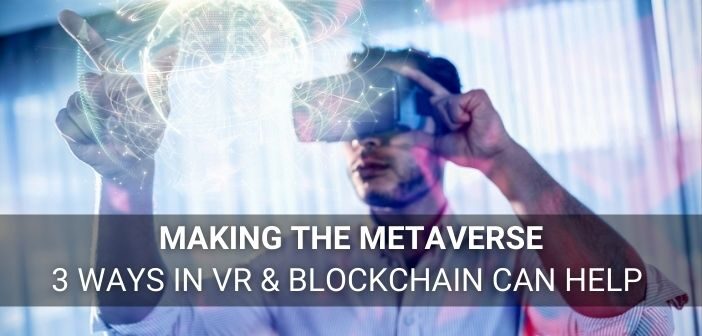Out of all the technological fields emerging from the computing revolution, two have captivated the public’s imagination the most – virtual reality and blockchain. As the economic maxim goes, “Progress beckons more progress”; the by-products of increasing computational capacity are going to become the basis of the next information revolution. With the growing interest in making metaverse(s) a reality, these two technologies will be the muscles and bones of the next big technological breakthrough.
Virtual reality, in the simplest terms, is any graphically generated world that a user can immersive themselves in. Blockchain, on the other hand, is a data encryption and ledger system that enables data security, validation and authentication. Putting these two together – the visual richness of VR and the utility of blockchain frameworks – gives us a glimpse of what life in the metaverse will be like.
Here are three ways in which VR and Blockchain can converge to shape the future of the metaverse:
Standardisation of VR Assets
Just as nature has shaped the physical reality we inhabit at present, graphic designers will be the creators of VR-run metaverses. The metaverse, for a simple user, will be an amalgamation of elements of their choosing, created by different artists around the world. With such a decentralised way of creating virtual reality, problems of irregularity in format, naming and code are bound to occur. Minimising these errors by assigning the task to a single company or team of designers is not a logistical possibility either.

Image Courtesy: Framestock from Adobe Stock
Here’s where blockchain can help: with the use of blockchain’s ledger, virtual reality assets can be maintained in standardized file formats despite the decentralised creation of elements. This standardisation is necessary to collaborative world-building, where coding errors and documentation lags can render entire sections unusable. A ledger system will also make it possible for users to dabble in creating and customising their own niches of a virtual ecosystem with little hassle.
Blockchain Copyright Protection – IPR in a Virtual World
The largest criticism of the internet has been the lack of suitable mechanisms to find out who the original owner of a file, piece of information or content is – which leads to copyrighting issues, especially for content creators and artists.
Non-Fungible Tokens or NFTs is one of the two file formats created by a blockchain. An NFT is anything registered on the blockchain’s ledger with a letter of authentication, certifying that the digital asset is an original. This ability to ascertain ownership has made NFT technology a facilitator of independent creation of art and music, with many creators making rapid shifts to create NFTs in order to fully own and monetize their works.

Image Courtesy: Дмитрий Киричай from Adobe Stock
VR-enabled metaverses, touted as the natural extension of the internet, will benefit greatly from this technology. To begin with, digital assets will now be able to factor in originality, availability and demand – enabling trade and commerce on these platforms. Extensive research on the behaviour of video gamers has shown that people are highly attached to their digital personas and willing to spend their money on them; with blockchain-enabled NFTs entering the picture, this tendency is only going to grow. Secondly, blockchain makes the asserting of legal claims over design much easier, giving content creators the monetary and legal protections they need to stay afloat.
Metaverse Security – Securing a Virtual Entity
Blockchain technology is the most cutting edge system developed for maintaining security across the internet. It is a closed-off data system where the public identity of a user remains undisclosed, yet their every action can be traced. This makes for an extremely objective and completely transparent accounting system untouched by human biases.
The importance of transparency cannot be overstated; a quick look at the Cambridge Analytica scandal and the misinformation debate, for example, makes it abundantly clear that lack of transparency amounts to zero accountability. User actions cannot be meaningfully monitored or flagged for abuse if there are no secure systems to do so – blockchain solves that problem without compromising a user’s personal safety.

Image Courtesy: Maksim Shmeljov from Adobe Stock
For virtual reality worlds, a blockchain-based information system means that user data remains transparent yet inaccessible. The implications of a data breach in a VR world will have even more serious consequences than typical internet-based data breaches – making the usage of blockchain not only recommended, but essential.
As the metaverse materialises, the two extremes of data computation are joining hands to make safe, interactive and commercially viable virtual worlds for users. Virtual reality has already made dramatic changes in industries such as entertainment and education. On the back of technologies like blockchain, fully VR worlds are on the horizon.



